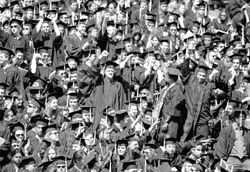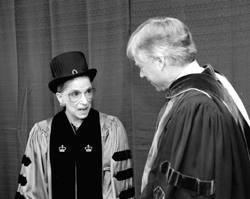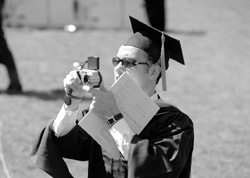By Joel Seguine, News and Information Services, and Britt Halvorson

Robert Pinsky, former U.S. poet laureate and professor of English at Boston University, and Marshall Sahlins, the Charles F. Grey Distinguished Service Professor Emeritus of Anthropology at the University of Chicago, gave commencement addresses at the end of April at graduation ceremonies and received honorary degrees from the University.
“Nobody remembers what the commencement speaker says,” began Pinsky, the longest serving U.S. poet laureate, in his address to the University’s undergraduate class of 2001 April 29 in Michigan Stadium.
Yet Pinsky termed commencement exercises “perhaps the most elaborate civic rituals in our American culture.” But what, he asked, do the ceremony and ritual mean? “Why are the young graduates wearing garments that suggest some remote era and yet at the same time emphasize how young many of you are?” He described a mysterious quality to the garb and the ceremony, which, he proposed, celebrates “two great obligations, two great tests that apply to every culture on Earth: caring for the young ones and honoring the old ones, including the ways and wisdoms of the dead.”
The mystery in the ceremonies, Pinsky continued, is greater than any sentiments we can articulate. We remember its vital form rather than its content.
“The tribe or community or nation that fails at either mission—honoring the old ones and teaching the young—brings woe and destruction on itself,” he declared.
Because colleges and universities are places where caring for the young and revering ancestors predominate, commencement exercises “present a transition between the two broad purposes of any people.” To transmit the memory of customs, wisdom and vital knowledge, we have devised language and writing. But we also transmit subtler messages such as, “ ‘I love you but not that way’ or where the best food is at what time of year. For this reason, art—poetry and painting and music and dance—are not ornaments at the fringes of human intelligence and accomplishment, but rather they are at the core of our intelligence,” Pinsky said.

“These ceremonies acknowledge our dependence on the chain of knowledge going back and forward,” Pinsky said. “Class of 2001, I hope that when you see caps and gowns, you will sometimes at least vaguely remember your debt to the old ones and how it obliges you to honor them by caring for the young.”
The other honorary degree recipients were: William Davidson, chairman, president and CEO of Guardian Industries; Ruth Bader Ginsburg, associate justice of the U.S. Supreme Court; Bill Ivey, chair of the National Endowment for the Arts; and Adam Michnik, a founder of Poland’s Solidarity movement.
Prominent anthropologist, educator and alumnus Sahlins delivered the graduate commencement address April 27 in Hill Auditorium.
Retired since 1997, Sahlins still teaches periodically. He received his bachelor’s degree from the U-M and completed his graduate studies at the U-M and at Columbia University. While a faculty member in 1957–74, Sahlins was credited with proposing the country’s first teach-in, which was held in 1965 at the University to protest the U.S. government’s increasing involvement in the Vietnam War.

A well-known theoretician and researcher, Sahlins’ body of work spans decades and numerous topics. He has done fieldwork in such locations as Turkey, Fiji and New Guinea. Sahlins’ work with Hawaiian peoples and his theories about the history of European contact in Polynesia have garnered much attention in anthropology. A member of the American Academy of Arts and Sciences, he engages in current debates about these and other topics relating to the future of the discipline.
In his address to graduate students, Sahlins touched on his time as a faculty member at the University. He described the political and intellectual climate of the Vietnam War era, noting that many liberal intellectuals felt betrayed when “so-called peace candidate” Lyndon Johnson authorized the massive bombing of North Vietnam. An increasing generation gap and developing youth culture, as well as something Sahlins described as “riot envy” on the Michigan campus, added to the activism of the students, faculty and staff.
Sahlins told of his own “footnote to history”: his involvement with the first teach-in. His late-night suggestion to a faculty protest group to hold a teach-in instead of a one-day strike is documented in Senate Document No. 72 of the 89th Congress, “The Anti-Vietnam Agitation and the Teach-In Movement: The Problem of Communist Infiltration and Exploitation.”

The critical insight he had to propose the teach-in is due to his Michigan education, Sahlins explained. “When I said, ‘teach-in instead of teach-out’ (the moratorium), I was just putting into practice the kind of Levi-Straussian dualism, the binary oppositions and symmetrical inversions, that were becoming all the rage in the analysis of exotic cultures and their transformations.”
Sahlins related other examples—such as the New York Giants’ 1951 National League baseball championship, won by Bobby Thomson’s dramatic home run—to describe how individuals become historical agents. He told the audience members to think critically, using their educations to make a mark with a fresh idea or approach.
“If you find yourself in a position to do something different—locally or nationally, politically or academically—do something interestingly different,” he advised. “If you go with the flow, no one’ll know. If you surrender to the social trend, the society will be the historical subject.”

